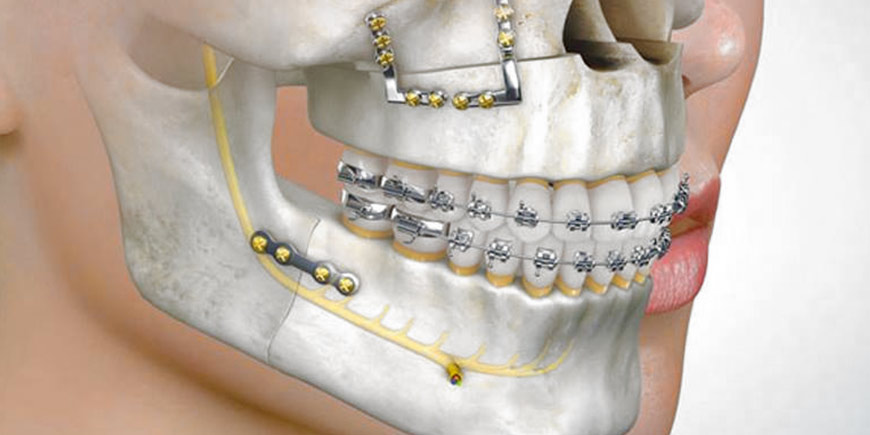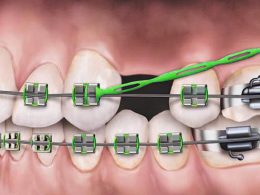Table of Contents
Orthognathic Surgery, from the Greek orthos (rectum) and gnathos (mandible), is a set of surgical interventions that are responsible for correcting skeletal malocclusions and dentofacial deformities, through maxillary and mandibular bone movements, to achieve the perfect balance between all features of the patient’s face. It is part of Maxillofacial Surgery.
This type of gnathological alterations are manifested in the growth phase of the patients, stabilize at the end of it and can cause great problems in the facial aspect, the bite and the temporomandibular joint (TMJ); as well as sleep apnea and skeletal disharmony, among others.
Hence the importance of an early diagnosis in Orthodontics, ideally before 8 or 9 years old. The vast majority of facial growth and development alterations can be corrected with Dentofacial Orthopedic treatments, through the use of special intraoral and extraoral appliances (other than brackets), capable of modifying the craniofacial growth pattern and reestablishing the lost balance.
While it involves a considerable sacrifice for the child and the parents the use of helmets, masks and palatal disjunctors, among others; it may be the only way to avoid going under the knife later. Once the biological growth peaks are exhausted (sexual development in women and average age of 12 or 13 years old in men), only two alternatives remain for the patient with severe skeletal malocclusion or dentofacial deformity: resignation or surgery, there is no other way!
However, when these malocclusions are mild, there is the possibility of correcting them only with braces, through so-called “camouflage” treatments, which usually consist of extracting permanent teeth to retract the incisors, improve the bite and hide the skeletal problem. But in the end, everything will depend on the patient’s facial characteristics and the Orthodontist’s criteria.
Jaw Surgery
Orthognathic Surgery must be performed by a Maxillofacial Surgeon, the only Specialist indicated to treat both the bones and the soft tissues of the face. There are three basic types of Orthognathic Surgery:
- Upper jaw surgery.
- Mandibular surgery.
- Maxillomandibular or combined surgery, also called bimaxillary surgery.
In essence, the Surgeon’s job is to surgically reposition the patient’s jaws and fix them, in a stable position that is compatible with the person’s bite and good facial appearance.
Types of Surgical Malocclusion
The relationship discrepancies between the maxillary bones can be of different types. Among the most common we are:
- Class II Also known as retrognathia or mandibular retrognathism. It occurs when the upper jaw protrudes with respect to the lower one, although in reality the most common is the opposite, an underdeveloped mandible.
- Class III Also known as mandibular prognathism. It happens when the mandible protrudes from the maxilla.
- Facial Asymmetry When one side, or part of one side of the face, is larger, smaller, or more prominent than the other.
- Gingival Smile When resting or smiling, an abundant and excessive amount of gum is exposed.
These alterations can be accompanied by other occlusion problems such as narrow palate, open bite, cross bite, edge-to-edge bite, increased overjet or dental crowding.
Orthodontics and Orthognathic Surgery
Orthognathic Surgery is closely related to Orthodontics. Therefore, the correction of skeletal malocclusions and dentomaxillofacial deformities will always involve teamwork between the Orthodontist and the Maxillofacial Surgeon.
This type of treatment is usually known in the profession as combined orthodontic-surgical treatment.
Study and Planning of Combined Cases
Perhaps one of the most important aspects of diagnosis in Orthodontics is to know, from the beginning, if the case is surgical or not; since the objectives of corrective and presurgical orthodontics are usually very different, and in many cases, radically opposite.
Orthognathic Surgery is one of the elective surgeries that are most frequently performed in Maxillofacial Surgery. Its planning must be meticulous, ensuring a degree of precision such that the margin of error is less than 1 mm in planned movements.
The classic planning method in Orthognathic Surgery is based on a facial analysis and a cephalometry performed from a lateral skull X-ray. From them, a surgical prediction tracing is made that allows to measure and quantify the desired surgical changes in the sagittal and vertical directions. At the same time, these displacements are simulated on plaster models (model surgery) to corroborate the expected changes in the tracing.
However, today we have newer tools for planning these cases, such as Cone Beam scanners, 3D computer programs, CAD-CAM surgical guides, and 3D facial models. However, the tools to be used will always depend on the preferences of the Surgeon and the complexity of the case.
Presurgical Orthodontics
In the conventional treatment scheme for combined cases (Orthodontics-Orthognathic Surgery-Orthodontics), the objective of presurgical Orthodontics (with braces) is to eliminate any dental compensation existing and provide the surgeon with a “surgical corridor” and stable, aligned and level dental arches; that allow him/her to perform the planned skeletal movements.
This stage of treatment, before surgery, can last between 6 and 24 months; depending on the complexity or severity of the case.
Surgical or Consolidation Arches
Patients are always operated with braces in the mouth, but before entering the operating room, they must have a heavy steel arch (consolidation arch) with surgical pins or hooks in place; either welded or prefabricated.
These hooks will assist the Maxillofacial Surgeon in the fixation of the jaws during surgery, allowing him/her to place the screws and mini titanium plates with greater precision and comfort. In addition, they are essential to attach the rubber or elastic bands that are usually indicated in the postoperative period to stabilize the bite.
Orthognathic Surgery of the Upper Jaw
Maxillary Surgery is performed to place the bone in a correct position so that it projects facial harmony and, most importantly, it is properly related to the lower jaw. All this is essential to improve oral function and the processes of chewing, breathing and phonation.
This surgery is performed to correct various facial deformities, such as maxillary prognathism, class III malocclusions, open bite, and gummy smile.
Monomaxillary Orthognathic Surgery consists of making a cut of the maxillary bone, called Le Fort I, which enables advancement, retrusion, lengthening, shortening or rotation of the bone. Once it is positioned in the desired location, it is fixed in place with plates or screws made of titanium, a completely biocompatible material.
This procedure is performed by our Specialists in the operating room, under general anesthesia and in an approximate surgical time of 90 minutes.
Orthognathic Surgery of the Mandible or Lower Jaw
Mandibular Advancement Surgery is necessary when people have a small and retracted lower jaw with respect to the maxilla, a condition known as retrognathia or class II malocclusion.
On the contrary, in cases of prognathism or class III malocclusion, a Mandibular Setback is performed to retract the bone and place it in a more posterior position.
This type of malformations especially affects the harmony of the lower part of the face, and causes various functional problems such as sleep apnea, for example.
Mandibular Surgery is performed through a bilateral sagittal split ramus osteotomy (BSSRO), which consists of making a cut on each side of the ascending ramus of the lower jaw, advancing or retracting the body of the mandibular bone and fixing it in its new position, using plates or titanium screws.
By anatomy, mandibular surgery is always much simpler than upper jaw surgery, and takes an average of about 40 minutes of surgical time.
Maxillomandibular or Bimaxillary Surgery
In most Orthognathic Surgery patients, it is necessary to reposition both bones (upper jaw and mandible), to achieve adequate occlusion and good facial harmony. This double procedure is known as Maxillomandibular Surgery or Bimaxillary Orthognathic Surgery.
Bimaxillary Orthognathic Surgery is used to treat the following skeletal malformations: class II, class III, facial asymmetry and open bite, among others; when monomaxillary surgery is not enough to correct the patient’s problems.
This procedure is performed by our Specialists in the operating room, with general anesthesia and in an approximate surgical time of between 2 and 3 hours. Generally, it takes 1 or 2 days of hospitalization before the patient can be discharged.
“When the Maxillary Bones Are Too Big, Small or Misplaced; It Is Necessary to Modify or Move Them Through Orthognathic Surgery”.
DENTAL TIP
Postsurgical Orthodontics
The continuation of Orthodontic treatment, after surgery, is essential to establish and stabilize the final occlusion. Generally, a period of postsurgical treatment with the Orthodontist of 5 or 6 months is necessary to complete the case.
Our Maxillofacial Surgeon works together with the best Orthodontists in the country. During the treatment of any patient suitable for Orthognathic Surgery, both the Maxillofacial Surgeon and the Orthodontist must know and master the essential aspects of the diagnosis and management of this type of case. They must also fully agree with the proposed treatment and the way it should be carried out, so that the patient can feel totally safe and confident.
Save Thousands by Getting Dental Work in Venezuela!
On average, dental work in Venezuela is about a third the price of what you are used to paying at home, without a drop in the quality of care. All the process takes is just a little research and a few more logistics. In the “Dental Tourism” category of this same blog we describe all the considerations necessary to get dental care done in Venezuela.
The first thing you want to do is get a quote for the dental work you need done by our team. Most of the time, simply sending a few photos and X-rays to us will do just fine. The online consultation will provide a strong idea of what will need to be done, and will be able to provide you with a pretty close cost estimate for the dental procedures.
Through our WhatsApp or Email you can ask all the necessary questions about the proposed treatment and its details. DENTAL VIP has specially trained personnel for this function.
Once the quote is approved, you must indicate the date of your trip to corroborate the treatment viability in the selected period, ensure your accommodation and proceed with the purchase of air tickets.
Congrats! Now you are on your way to saving thousands by getting dental work in Venezuela.












